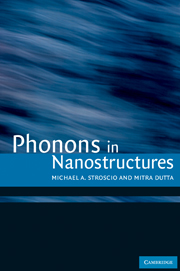Book contents
- Frontmatter
- Contents
- Preface
- Chapter 1 Phonons in nanostructures
- Chapter 2 Phonons in bulk cubic crystals
- Chapter 3 Phonons in bulk würtzite crystal
- Chapter 4 Raman properties of bulk phonons
- Chapter 5 Occupation number representation
- Chapter 6 Anharmonic coupling of phonons
- Chapter 7 Continuum models for phonons
- Chapter 8 Carrier–LO-phonon scattering
- Chapter 9 Carrier–acoustic-phonon scattering
- Chapter 10 Recent developments
- Chapter 11 Concluding considerations
- Appendices
- References
- Index
Chapter 10 - Recent developments
Published online by Cambridge University Press: 09 October 2009
- Frontmatter
- Contents
- Preface
- Chapter 1 Phonons in nanostructures
- Chapter 2 Phonons in bulk cubic crystals
- Chapter 3 Phonons in bulk würtzite crystal
- Chapter 4 Raman properties of bulk phonons
- Chapter 5 Occupation number representation
- Chapter 6 Anharmonic coupling of phonons
- Chapter 7 Continuum models for phonons
- Chapter 8 Carrier–LO-phonon scattering
- Chapter 9 Carrier–acoustic-phonon scattering
- Chapter 10 Recent developments
- Chapter 11 Concluding considerations
- Appendices
- References
- Index
Summary
Nothing is too wonderful to be true, if it is consistent with the laws of nature, and in such things as these, experiment is the best test of such consistency.
Michael Faraday, 1849Phonon effects in intersubband lasers
The effects of dimensional confinement on optical phonons, phonon-assisted electron intersubband transition rates (Teng et al., 1998), and gain (Kisin et al., 1997) have been evaluated in a series of studies on semiconductor lasers. Many of the novel semiconductor lasers – such as the tunneling injection laser and the quantum cascade laser – contain quantum wells with confinement dimensions of about 50 Å or less. An example of such a semiconductor laser structure is given in Figure 10.1. In this laser, the conduction band is engineered so that the upper and lower energy levels are E3 and E2 respectively, with a third level, E1, such that phonon-assisted tunneling from level E2 to level E1 is promoted. The IF optical phonons are of special importance in such heterostructures. Two properties of the IF optical phonons account for their special significance (Stroscio, 1996) in narrow-well semiconductor lasers: (a) in narrow wells the interface phonons have appreciable interaction potentials throughout the quantum well since, as was demonstrated in Chapter 7, the interface optical phonons have potentials near the heterointerfaces of the form ce–q|z|e–iq·ρ, where, for example, q has values of very roughly 0.02 Å–1 for a typical intrasubband transition in GaAs; and (b) the energies associated with phonon-assisted processes in these heterostructures can be substantially different from those in semiconductor lasers without significant dimensional confinement, since the interface phonons may have frequencies ωq which are significantly different from those of the other phonons in the quantum well.
- Type
- Chapter
- Information
- Phonons in Nanostructures , pp. 186 - 217Publisher: Cambridge University PressPrint publication year: 2001



